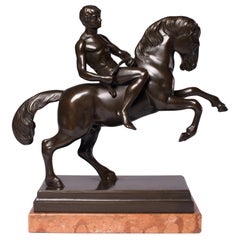19 Th Century Figurative Statue
Recent Sales
Antique Late 19th Century Italian Classical Roman Figurative Sculptures
Marble, Bronze
19 Th Century Figurative Statue For Sale on 1stDibs
How Much is a 19 Th Century Figurative Statue?
A Close Look at classical-roman Furniture
During Mount Vesuvius’ eruption in 79 A.D., Pompeii and Herculaneum in today’s Italy were preserved as they were on the day of their destruction. Particularly at Herculaneum, furnishings were carbonized beneath volcanic ash. This was pivotal to understanding how Classical Roman furniture was designed. Archaeological investigations and printed reproductions of discoveries would influence styles evoking this ancient civilization, from the Renaissance to neoclassicism.
While knowledge of Classical Roman furniture comes from rare surviving pieces, it is also derived from frescoes and sculptures portraying Roman life. Much of Roman art, architecture and design was informed by Greece — Roman architect, military engineer and writer Marcus Vitruvius Pollio, whose timeless De architectura is taught in contemporary architecture classes and pays tribute to classical architecture, visited Greece while working under Julius Caesar and admired the country’s architectural developments. The Roman solium references the Greek thronos, a stately chair of honor with an upright form and footstool. As the Roman Empire spread across Europe and into North Africa and Western Asia, the expansion of trade for silver, silk, marble and wood allowed for more luxurious designs.
Classical Roman furniture was made from bronze, wood and stone — in particular, marble — with ornate touches like tortoiseshell veneers, bone and glass inlays and claw feet. Ornaments depicting lion heads and mythological figures were sculpted from silver, bronze and ivory. Compared to the decorative attention given to the mosaic floors and wall paintings, however, furniture for even a wealthy house was minimal. It focused on the necessities for guests arriving for both socializing and business and the rooms housing family, relatives and enslaved people.
The triclinium dining room had banquet couches, items so prized they were sometimes interred with the deceased. Tall bronze or terracotta candelabras held oil lamps for lighting. Carved marble tables reflected status, while the lararium home shrine demonstrated faith.
Find a collection of Classical Roman decorative objects, tables, seating and other furniture on 1stDibs.
Finding the Right figurative-sculptures for You
Figurative sculpture is a modern art form in which artists create work that is typically representative of the visible world. However, sculptures that are considered to be figurative in style can definitely be inclusive of abstract elements. A wide range of antique, new and vintage figurative sculptures has been made over the years by both well-known and emerging artists, and these pieces can prove striking and provocative as part of your home decor.
Realistic representation in visual art has a very long history. And while figurative artists, whether figurative painters or sculptors, find inspiration in humans, animals and real-life objects, good figurative sculptures can make us think differently about how the real world should look. Just as figurative paintings might include Photorealistic human likenesses, they can also include elements of Surrealism and can suggest a creative and alternative reality. Figurative sculptures aren’t always realistic impressions of our world — depictions of the human form in classical Greek sculpture, for example, might emphasize beauty and physical perfection.
There are a variety of figurative sculptures on 1stDibs created by artists working in a number of styles, including Art Deco, Art Nouveau, mid-century modern and more. A large figurative sculpture can introduce an excellent focal point in a guest bedroom, while smaller works might draw the eye to spaces such as wall shelving or a bookcase that people may otherwise overlook.
When decorating your living room, dining room, home office and study areas with figurative sculptures, don’t be afraid to choose bold colors to inject brightness into neutral spaces. Texture is another factor to consider when purchasing figurative sculptures. A highly textural work of ceramics or wood will catch the eye in a sleek modern space, whereas a smooth, flat glass sculpture can offer an often much-needed contrast in a room that already has many textures.
On 1stDibs, find antique, new or vintage figurative sculpture or other kinds of sculpture for your home decor today.
